Taipei, 2 March 2006
Dear Gabriella,
I arrived in Taiwan on Tuesday and I'm starting to settle into the studio at Taipei Artists Village (TAV). I will be here until May 6th with the intention of producing a new installation for exhibition at the end of the residency. I haven't really anticipated anything as yet and have arrived here with a 'blank canvas' so to say. I'm starting to plan and divide up my time which will begin with some traveling, venue visits and meetings.
The TAV team have already been very helpful and I had an initial meeting with the the Director Ms Yaohua Su, and have explained that I would prefer to work and exhibit in a site-specific context rather than a classical white box gallery space, as I feel this would bring about a greater conceptual response and reaction to the environment I'm working in.
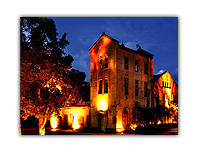
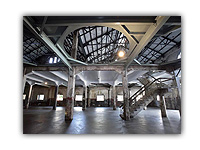
Yesterday (1st March) I visited the Huashan Culture Park (http://huashan.cca.gov.tw) in Teipai, which is a renovated winery. There are some very large fantastic warehouse type spaces here, which would be perfect for large scale projection works. However I'm not entirely sure this space and the kind of work it necessitates would allow me to engage at the social and cultural level I intend.

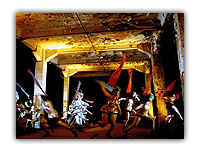
This afternoon (2nd March) I'm going to visit a housing complex built by Chinese soldiers in 1949 after the retreat of the Japanese occupation. The houses were built without any particular architectural or town planning and sprung up in an ad-hoc organic model. There is now a preservation order on the buildings and a group of Taiwanese artists and curators are involved in this. It's still not 100% sure if the space is available, but it sounds extremely interesting - I will know more very soon.
Best,
Paul
The above images are from the Huashan website.
Exeter, 2 March 2006
Dear Paul
Many thanks for your email. Things sound really interesting and it must be so stimulating to be in such an inspiring environment.
I'm intrigued by the idea of the white canvas within such a rich and complex context and am wondering what the effect of these extraordinarily different spaces that you describe in your email might be on a telepresence work. I mean, how does cultural context, in all its presentness, affect tele-presence, in all its absentness?
I have put it up on the collaboratory with some pictures from the link you sent. I have also done a little edit in the latter section. Please feel free to suggest that I reinstate the original, is you wish, and/or suggest other edits at any time. I'll of course put up any pictures you send our way. I'll also copy in this email on the collaboratory.
I look forward to hearing from you soon.
warm regards
Gabriella
Taipei, 3 March 2006
Hi Gabriella,
Some images attached of the locations I have visited. The Chinese housing complex I spoke about is called Treasure Hill, this was a really inspiring space and several of the houses have been purchased by the city government and turned into artist studios/galleries.
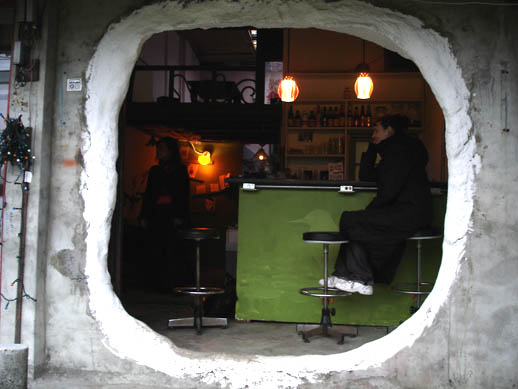
The artists are working with a lot of found objects and using the space as living/working/studio/exhibition environments, turning one of the spaces into a bar also.
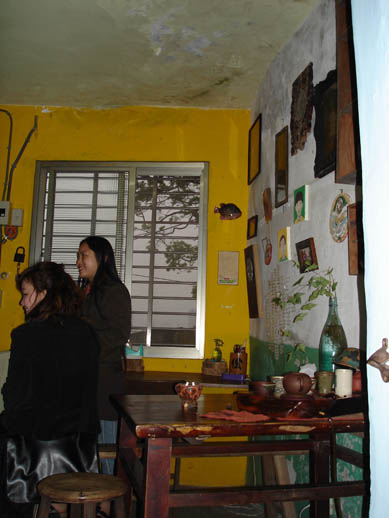
But in general I don't think it is possible to use the space for a media art installation, it's just not secure enough, it's also very damp and electrical supplies are not reliable.
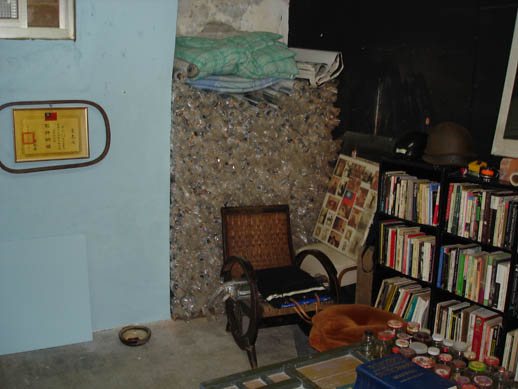
But anyway - very inspiring. I'm also attaching a photo from The Huashan Culture Park I visited Wednesday to give you some idea of the scale of the space.
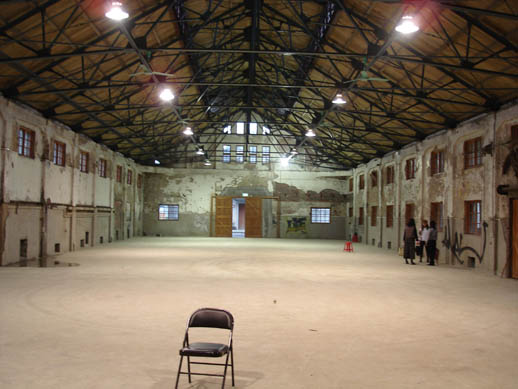
They also have some small studio/bedroom spaces here at Taipei Artists Village which I could use to produce an installation work which could draw some of the thoughts gathered from Treasure Hill. I will talk more about the concept emerging here in my next email.
I'm intrigued by your notion absentness in the telepresent space. In my work/notion nothing is absent but rather becoming redefined - the absence of touch is embodied in the expanded sense of sight. The same could be said for blind person - the absence of sight is embodied in the expanded sense of touch or sound. Can we expand this to cultural experience?
More soon,
Paul
Exeter, 6 March 2006
Hi Paul
Many thanks for your email, which is now online, alongside the fascinating pictures you sent. The bar is amazing, like a cavern, or a hole produced by an explosion. You mention the bedroom spaces - does this make you think of Telematic Dreaming and using a bed again?
The rooms look small and busy, full of traces and histories. Can I see lots of bottles? Or glass? And the books, of course... what is strange for me is that I am struggling to tell whether the rooms are public or private spaces. Somehow, they invite the viewer to explore and yet have that 'do not touch' aura! Andrea's (see Andrea Zapp) installation Human Avatars cames to my mind. I remember spending ages reading all the cards, touching the objects, and then feeling guilty about it because I was reading private correspondence! Are these rooms of the past or are they in use? They exude presence to me...
I agree that in your work everything is about presence. One could even talk about a multiplication of presence. So, with The Tables Turned, or in Dissociative Identity, for instance, I had the neat sensation of being, at the same time, here and there. I couldn't work out if, during this process, this presence was in effect the result of a process of excess or one of dilution. But yes, as you say, 'the absence of touch is embodied in the expanded sense of sight.' I am at once moving my arm, head, body, in my space and am moving in the telepresent space alongside with, and often in response to, the other telepresent viewers.
But where was my awareness? At a personal level, I was aware of what I was doing in the telepresent space. So, arguably, while I was present in both spaces, perhaps I was only self-aware in any one space at the time, continuously shifting from one to another, depending on how much audience was watching me, or how much interaction was possible. So, yes, all my senses had to work harder and were indeed augmented, or expanded. But while I was at once all present (tele-present) I was also 'dissociated', fragmented even. This is why I also perceive an absence, though I don't know from what, and why I think your work is so complex.
You ask in your email whether we can 'expand this to cultural experience?' Could you clarify what you mean? Do you have A Body of Water in mind where the interplay was so much also an aerchaeological journey? Michael Shanks might have more thought here...
All best wishes.
Gabriella
Taipei, 7 March 2006
Hi Gabriella,
I've visited another site yesterday, located to east of the city in the shadow of the 101 tower and Taipei's world trade centre. Similar to the last site this is a Taiwan War Veterans housing complex built around 1949, but this site has been renovated and converted into a museum and exhibition space. It sits on some of the most commercially sought after space in the city but because of its historical importance to the liberation of Taiwan it's a listed building.
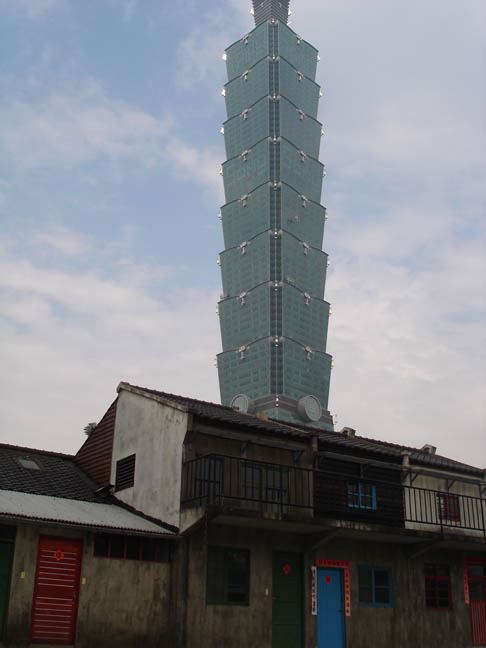
The back to back terraced streets have been knocked through into entire buildings, creating three large exhibition halls inside, with the original appearance of the houses on the outside.
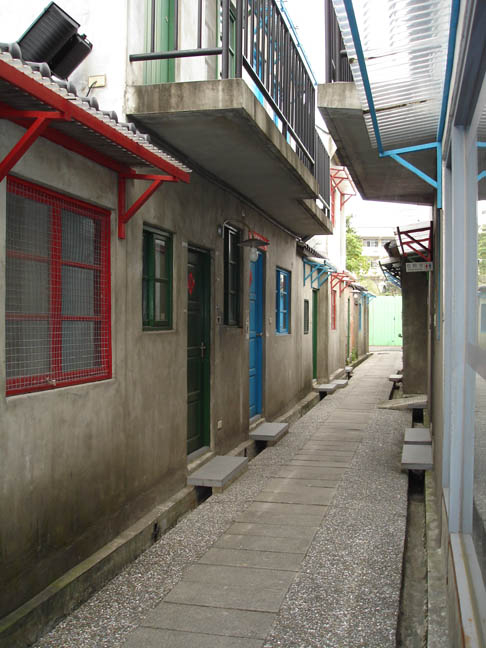
The spaces that interested me most were the small facade rooms created by the larger space conversion. These have been separated from the gallery space by interior glass walls and are only accessible from the external outside doors.
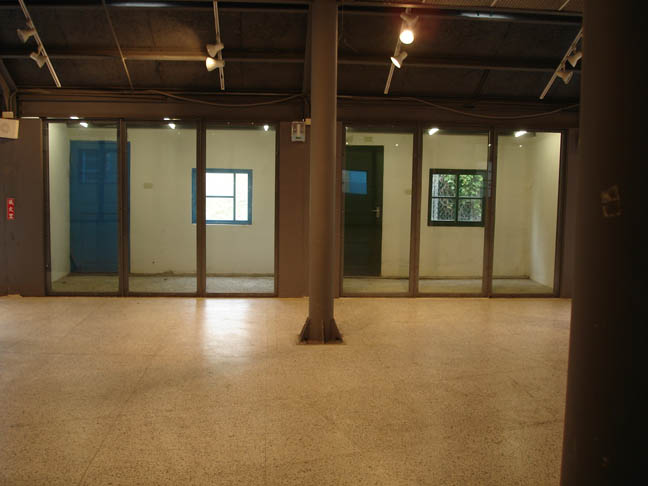
These two facade rooms are identical in size and could potentially be used to house a connected telepresent installation. It's also interesting that the audience in the gallery can observe the participants in the space through the glass, but the people in the facade rooms can not see the other user in the facade room next door.
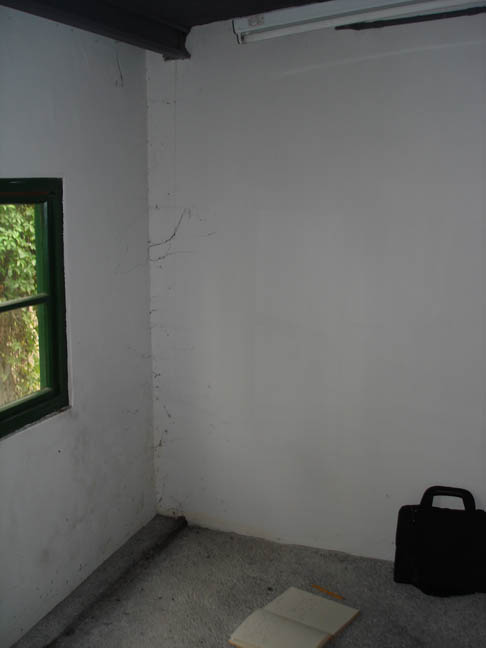
Both rooms are only about 2 meters by 3.5 meters and 2 meters high. The original houses were longer, but no wider and they often halved the the height of the rooms to created separate sleeping and living areas. This was also explained in an attached permanent museum exhibit in one the gallery spaces.
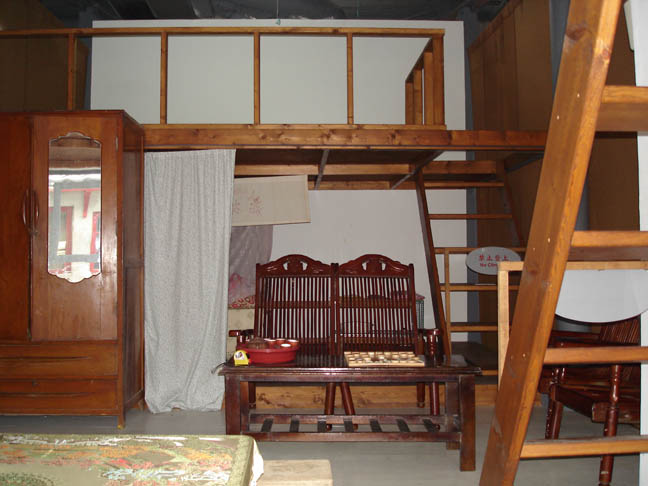
This split level of the space interests me, rather like the outside of space that contrasts with the looming 101 tower in the background in stark contrast to the little houses huddled around the base. This can be said for much of life in Taipei. Such as very very basic noodle bars and soup kitchens between KTV clubs (karaoke), 7/11's, high rise office blocks and countless temples devoted countless incarnations of the Buddha and superstition.
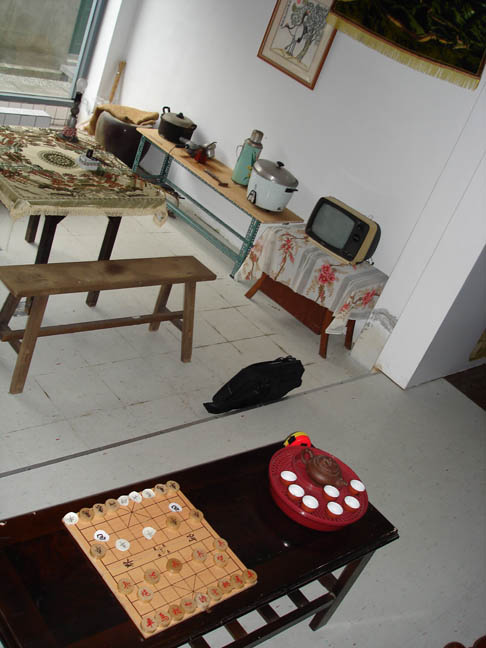
I am interested in the archeology and history of the space and its interior, the very basic living conditions (bear in mind this a museum reproduction) that is still very reminiscent of the way people live today, and yes in a similar way to A Body of Water (1999) but I'm also interested in the places and ways people escape experience in temples/shrines and KTV bars that are also found in many homes. This is definitely a telepresent space I need to explore (but I won't do any singing - yet).
I will be working on the first draft plans for the installation this week and hope to do some traveling around Taiwan towards the end of the month to explore these ideas further.
More soon,
Paul
Exeter, 9 March 2006
Hi Paul
Many thanks for your email and the amazing images. There is such acontrast and dialectical tension between the tower and the housing complex and then again between the outside and the inside of the building.
The facade rooms are extraordinary! It's like a gallery within the gallery except access, as you say, is from the outside. This makes me wonder about what is inside and what is outside and how one may have to go outside, in order to be inside. Also, as you say, the participants won't be able to see each other except in telepresence, while the 'audience' in the larger gallery behind the glass window could see 'everything'. This could add a further, theatrical, dimension to the piece because the participants in the two rooms could perhaps also see the 'audience' behind the glass. This would open up questions as to who is watching whom and through what strata (television, telepresence, glass, screen) that are fascinating and again very archaelogical.
The theatre director Mike Pearson did a workshop for us yesterday, and said 'in the space between presence and absence the archaeological imagination is born'. This made me think of your pictures and these tensions between proximity and distance, presence and tele-presence.
best wishes from a very rainy and stormy Exeter
Gabriella
Taipei, 15 March 2006
Hi Gabriella,
The venue and location (the two rooms with glass wall) have now been confirmed. The installation will run from April 4th to 20th, press conference on the 6th and opening event on the evening of the 8th. I will be installing from March 27th to April 3rd, so I now have about
two weeks to prepare the installation and develop the concept, which have already started.
The technical description I have prepare is as follows...
HEADROOM (working title) - Technical Description
This project functions by combining two identical room installations within the same video image via simple video conference techniques.
The system works as follows. The two rooms both have false ceilings lowered to a level of approximately 1.5 metres, this leaves a cavity space above each room of approximately 1.2 meters high and will also force the gallery visitors to bend down when entering the spaces. However there will be one location in each room where the viewer will be able to stand up straight and put their head and hands through a hole in the false ceiling and into the cavity space. Although each room will share identicle dimensions they will have a different appearence. One of the rooms will contain drab used furniture in the lower part with a very lived-in appearance, the cavity space above it will be very dark, with the exception of a video projected image and some small lighting effects. The other room by contrast, will not contain any furniture in the lower section and will be very bright in the cavity above, including green or blue lit walls.
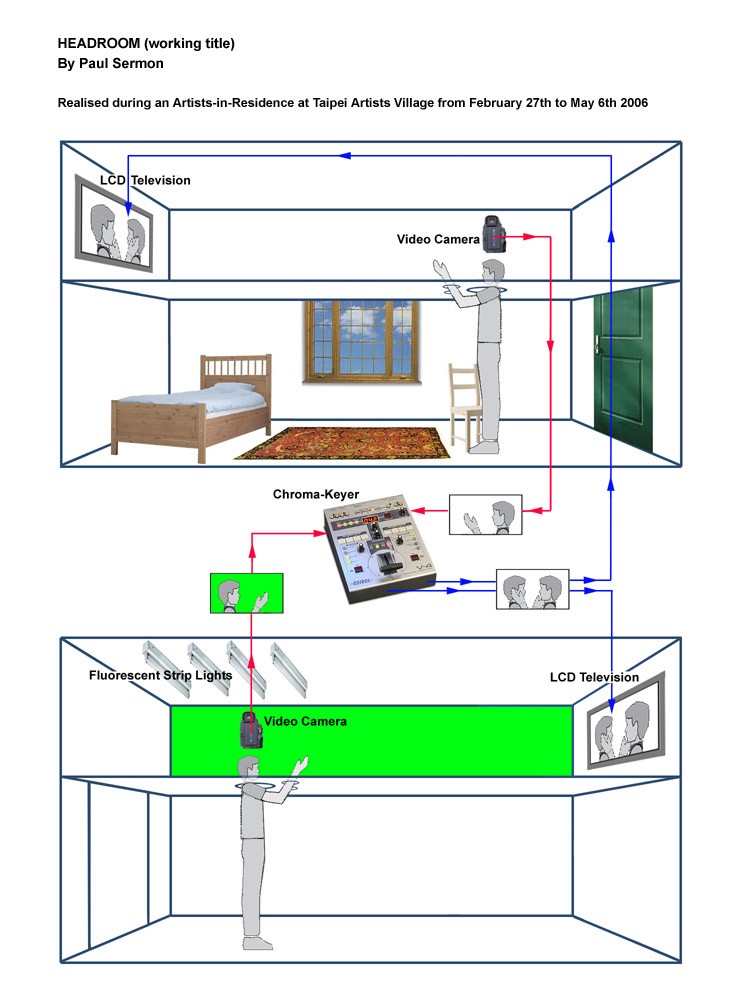
A video camera in each space will record a live image of the head and arms of each participant and feed it directly to a video chroma-key mixer. One of these head shot images will be recorded against a green or blue background which will be extracted by the video mixer and replaced by the other live head shot - placing the two heads opposite each other within the same live video image.
I'm working on the conceptual idea further, but the space below will resemble a very small Taiwanese bedsit space which will be ambiguous and could also be thought to be an actual temporary shelter for a homeless person - of which there are some in the area. The space above is an escape to an alternative world of intimate proximity with another (telepresent) person. I'm working on this space but it will also be an ambiguous mixture of content drawn from my visits to Taipei's temples, shrines, KTV clubs and television, whilst simultaneously being an analogy of an intimate Internet encounter.
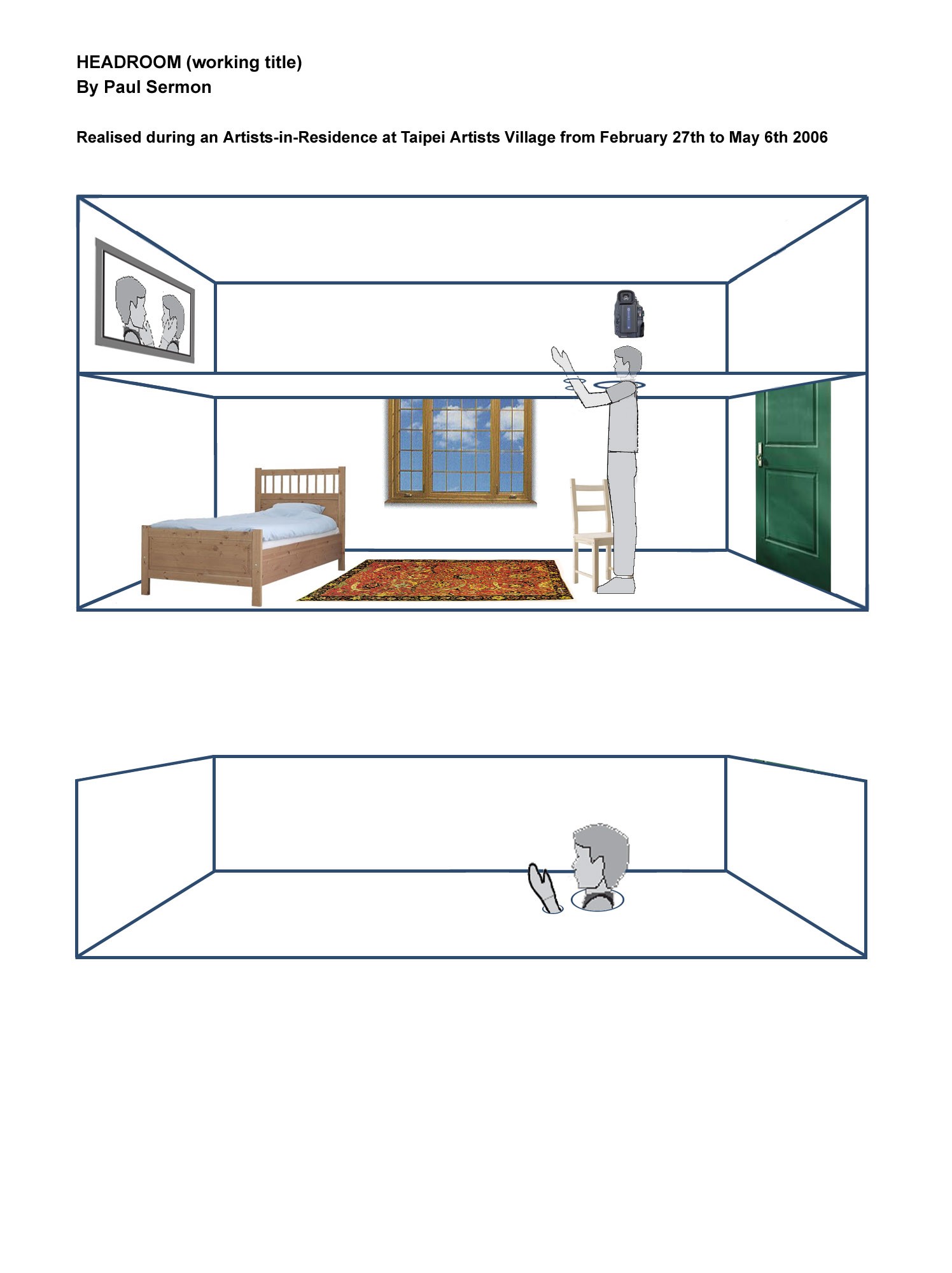
I will provide more visual references to this in my next email.
Best,
Paul
Exeter, 19 March 2006
Hi Paul
I'm particularly fascinated by the site-specific aspects of the work, especially some of the questions that arise for me in the technical outline for Headroom.
Headroom seems to bring together very different kinds of locations through the participation of its visitors. There appears to be a very striking juxtaposition between the concrete location in which the participant stands, the removal from this place in the headroom above, and the interaction with others in the virtual space. Each of theses 'places' is articulated in a powerful set of references: the homeless shelter, the white gallery-room, the bar, the intimacy of the internet.
Juxtaposition may be the wrong term, though, as it seems that, in the telepresent exchange of its participants, there may be the implication of being at once 'in and out' of multiple sites, or even of performing these sites one through the other.
This thought also picks up on Gabriella's note on the experience of being 'here and there' in the telepresent exchange.
This led me to a number of questions, which relate how one is 'present' (or located) in this work's site-specificity. These were:
Can one talk about a 'telepresent site'?
Or is it more appropriate to think in terms of what telepresence does to the idea and practice of its specific sites?
And do these telepresent exchanges produce in some sense another, distinct space formed in a performance - or tracing - of one site over another?
It's very exciting to see the work unfold in this process. Look forward to seeing the developing material.
All best,
Nick
Taipei, 21 March 2006
Dear Nick, Gabriella,
This is exactly what I'm trying to draw attention too.
This juxtaposition between the location of the space and its surroundings, between the experiences and sights of the city, between the way people live, as in Treasure Hill, and the way people escape through the abundance of neon lights, temples and KTV clubs, serving as an analogy between the solitude presence in the bedroom space below and the divine telepresent aspirations in the Internet space above.
This is also in part referencing Roy Ascott's essay, Is There Love in the Telematic Embrace? (1990), where Ascott attempted to attribute to electronic art the potential to embody love. Roy Ascott addressed a common concern amongst critics of electronic art at the time: the fear that technology would overwhelm and dehumanize the arts, a last bastion of humanist values. If it could be shown that telematic art had the potential to embody love, then it would not be a paradox for art to be electronic and simultaneously serve humanist principles.
In an unusual way this exemplifies it too....
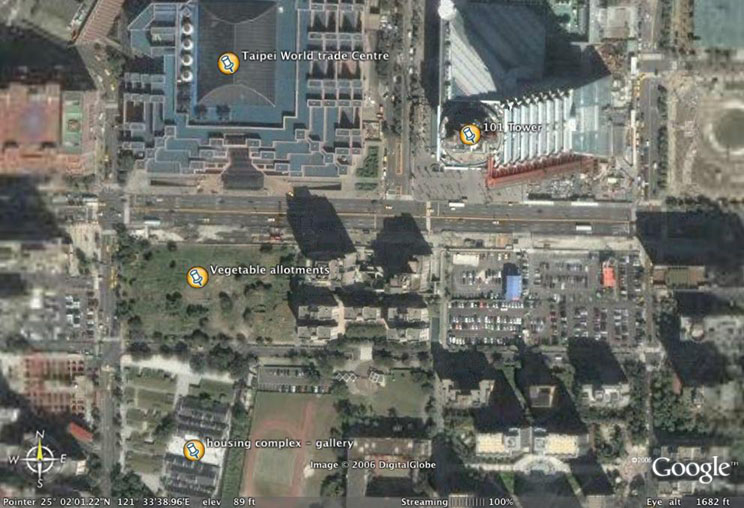
The google earth image shows the location of the gallery, and also in complete contrast a plot of vegetable allotments that occupy the opposite side of the street from the Taipei World Trade Centre.
In reply to your questions, I will try to formulate the reasoning behind the (the above) headroom space. As a neutral observer and not wanting to sound like a confucius philosopher, the temples and shrines here are designed and constructed to emanate divine wisdom from the Buddha to the worshiper through an elaborate symmetrical
display of surrounding lights and decorations that frame the Buddha, as a portal or gateway (and I mean this in a telematic sense too) to love and happiness.
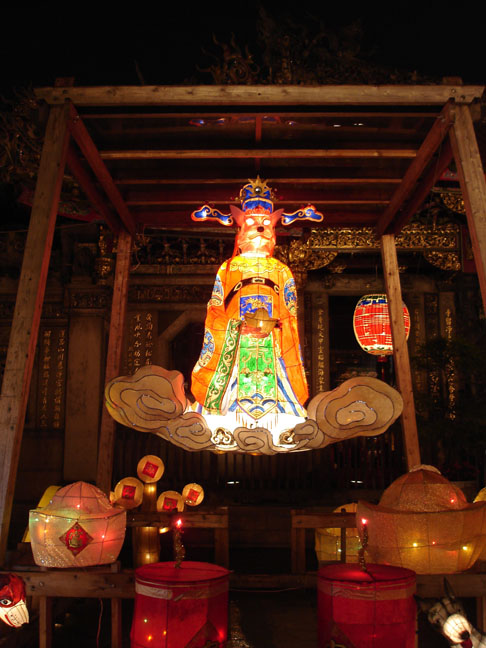
Also reminiscent of Nam June Paik's early Buddha TV installations. This is a reflection of the self in the telepresent space simultaneously as the viewer, as the performer and as the controller of this private and intimate meeting/encounter. The television 'screen' is transformed into a stage or a portal to the 'telepresent site' which we can only talk of in relation to the observer and controller/performer of the visual cause and effects that takes place in this shared space, and simultaneously in the minds of the
participants as solitary viewers - the experience of being 'here and there' in the telepresent exchange.
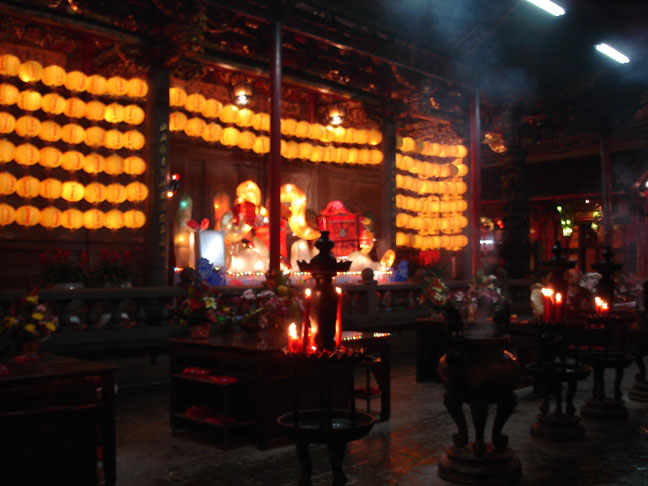
Some other images that help tell the story...
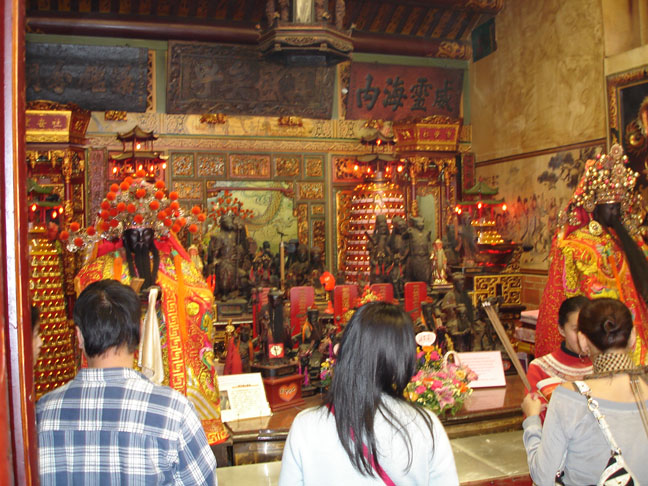
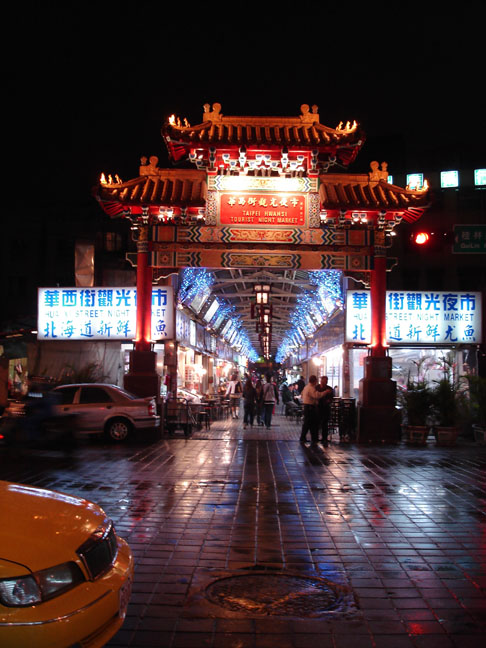
More installation construction images to follow soon.
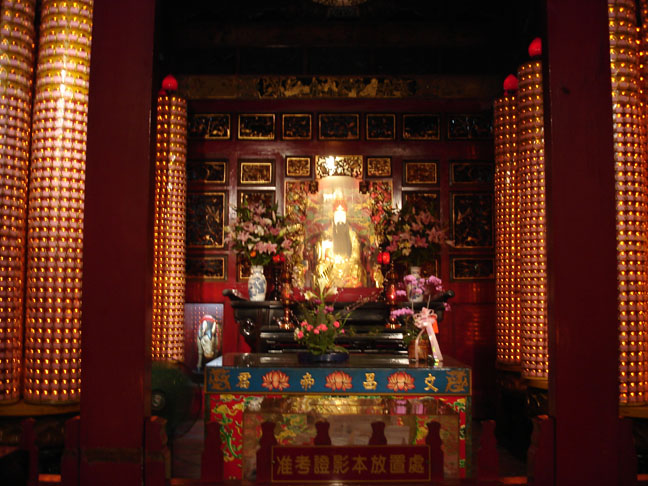
Best,
Paul
Exeter, 23 March 2006
Hi Paul
Many thanks for the amazing pictures.
The more I look at the diagrams, the more complex the piece appears.
Will the users have to bend down to get into and be within the space? If so, their perception of the rooms will be interestingly distorted. And, of course, their only possibility of standing in the room will effectively take them out of it and re-locate them in an entirely new space, as well as the telematic space. So, if I understand correctly, the viewer could be in 3 spaces (the first two being represented by the head and body space in their own room, and the third one by the telematic space).
Do you envisage one user at the time to use the space? Or might it be possible that while someone is engaged telematically someone else will be crawling around them in the lower space? This could produce very charged situations in which one may have increasing telematic presence and control whilst losing the sense entirely of their own bodily reality (in the lower space). I find this politically fascinating.
I like that each room appears to have one section that is empty...
There is a lot of colour (red especially, and orange or yellow) in your photographs - might this come back somewhere? What is the importance of the green colour?
Many best wishes
Gabriella
Taipei, 24 March 2006
Hi Gabriella,
My research into life in Taipei and birthday celebrations for my 40th have come together...
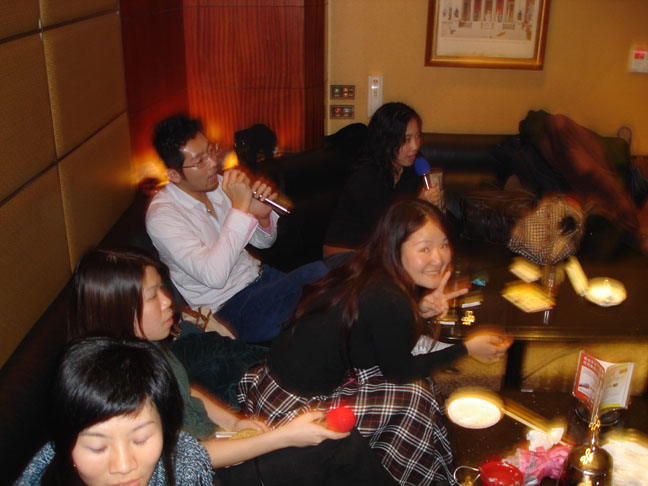
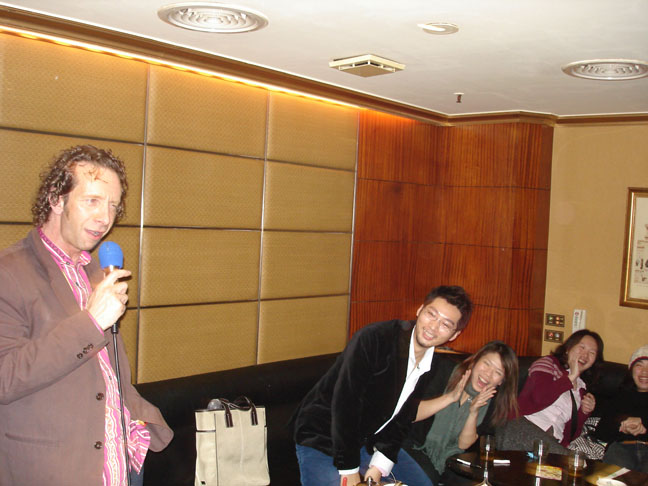
and following a lecture earlier in the day at the National University
of the Arts...
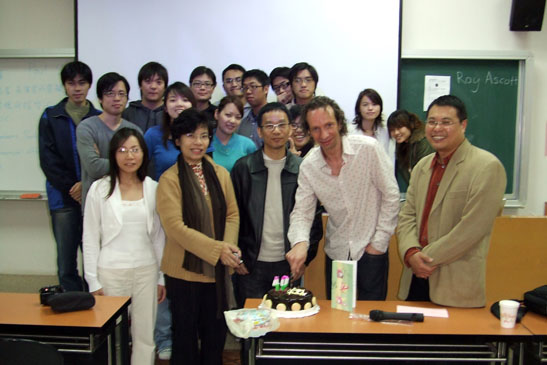
having red curtains made for the HEADROOM installation...
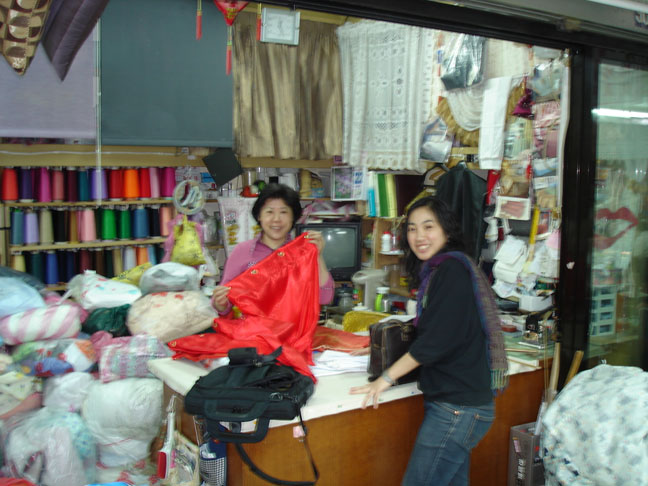
I hope these photographs help complete the picture of my residency.
I will respond to your questions and provide some updates on the installation construction which all starts monday 27th.
Best,
Paul
Exeter, 24 March 2006
From the entire Presence Project Team
HAPPY BIRTHDAY!!!
All best for the installation.
Till soon
Gabriella and all
Taipei, 26 March 2006
Dear Gabriella,
I'm attaching two diagrams that illustrate the construction involved next week during the installation set up.
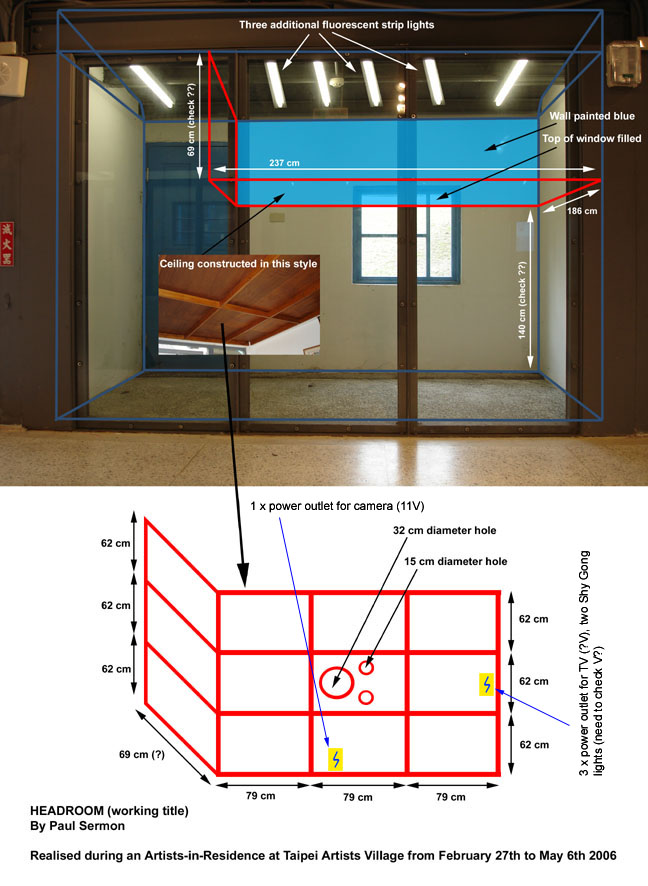
Only two thirds of each space will have a lower ceiling level so it will be possible to open and close the doors to the spaces. This will also create a small
space where it is possible for the audience to stand and read a statement about the work on the wall before having to bend down to enter the space, I'm not intending on limiting the amount of people in each space, but it will only be possible for one person at a time to stand up and put their head through the hole in each room.
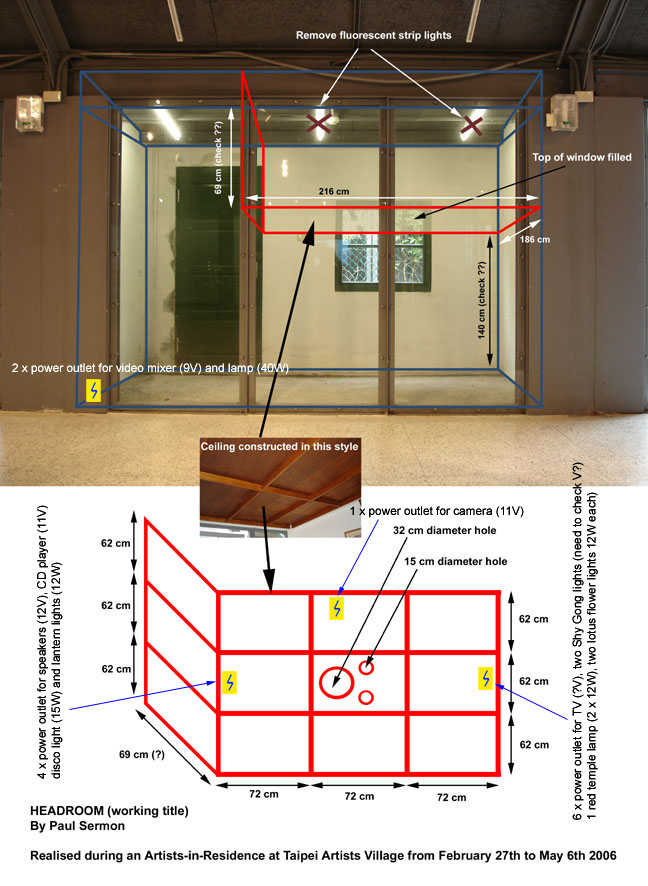
The room above will be decorated entirely in red drapes and curtains. In the other head space the one wall will be painted blue, rather than
green, in order to complete the chroma-key compositing process. I will send a more detailed description of these spaces as they start to materialise next week.
Best,
Paul
Exeter, 26 March 2006
Dear Paul
This is extremely interesting to us and we are very much looking forward to seeing the first pictures of the actual work.
Here is a question: what do you think is the difference between immersiveness and presence in this work? in other words, how do you think immersiveness will work, given that the upper torso is immersed in one world, and the lower in another?
Hope you're well.
best
Gabriella
Taipei, 28 March 2006
Dear Gabriella,
This is an interesting question. The entire head space will not be visible to anyone else except the people inside it so it will be very intriguing to see how the visitors inside the the main gallery space interpret and read the movements of the headless body behind the glass wall, and also how these headless bodies behave as they are conscious of being both private (above) and public (below) at the same time. As with much of my work it will only be possible to measure the level of immersiveness and interaction within the piece when we first see how the visiting public start to enter the space.
Some images from the construction of the installation so far, beginning with the electrical supply...
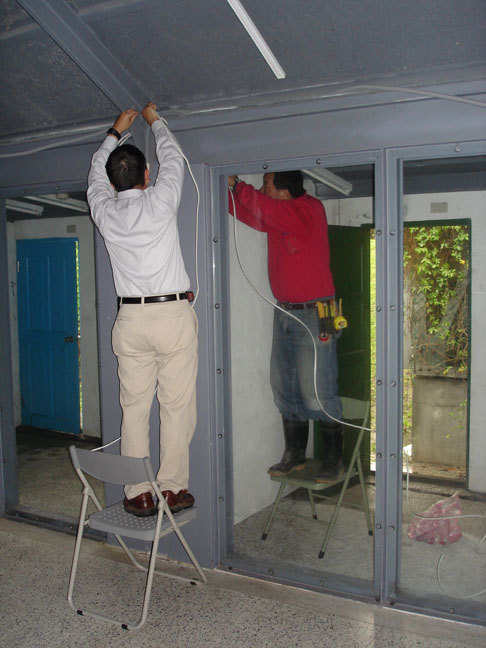
and the entire wood construction work that was completed in a single day by Mr Huang's very efficient and helpful team of carpenters...
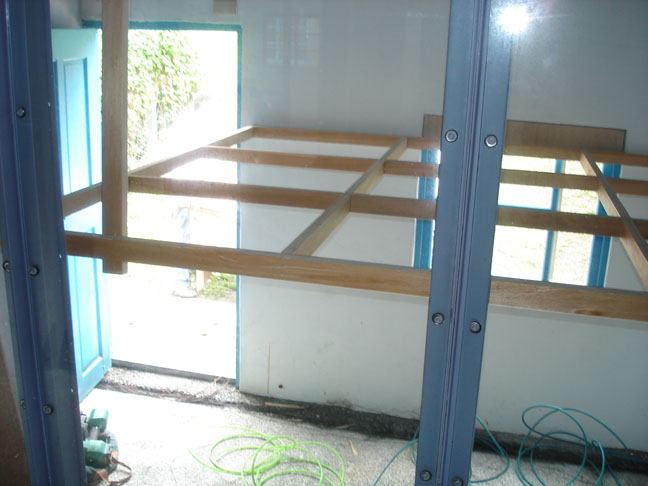
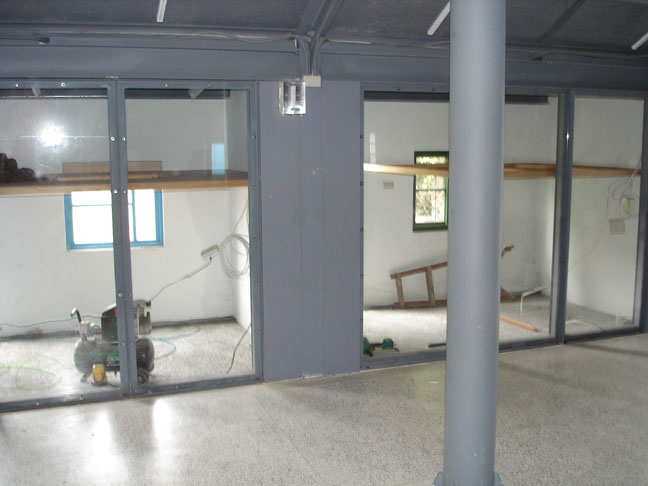
who also helped provide some human dimensions...
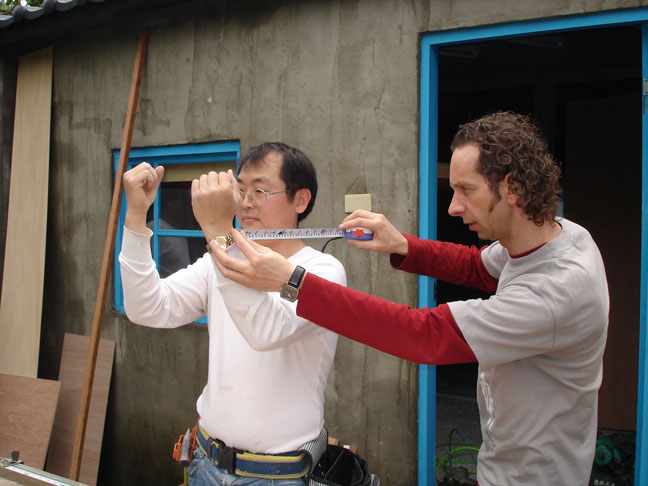
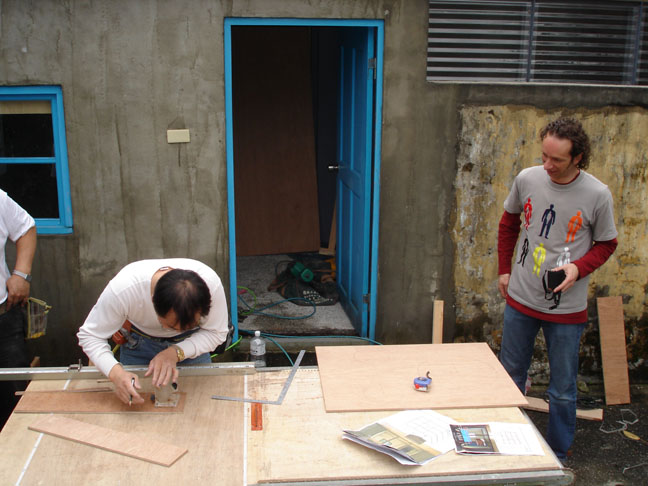
More soon,
Paul
Exeter, 30th March, 2006
Dear Paul
Just wondering how things are going - we're both very intrigued to see the images of the installation as it comes into its final form. And we wonder if it will be possible to provide images from its various vantage points to see how we can reflect on this visually on the Collaboratory.
It will be very interesting to see how the juxtaposition of the different perspectives might articulate the kind of dispersal and layering of point of view and presence we've been discussing.
Best from both of us,
Gabriella and Nick
Taipei, 4 April 2006
Dear Gabriella and Nick,
It's been a tough week, but the installation opens to the public today, with a press conference on Wednesday and private view event on Saturday 8th. The most difficult part was getting the headroom space correct. It was tricky getting the balance right between the ambiguity of the intimacy/seduction and the shrine/temple focus on the screen. I did this part several times and had to extract many elements before I was happy with what I got, but not surprising it all started to fall into place when I started to move the furniture into the room bellow. I will send some more images very soon to illustrate this in more detail. I need to now start documenting the public reaction and use of the installation in detail. The following photographs were taken with students from Professor Yung-Hsien Chen media arts class at The National Taiwan University of the Arts.
More soon, Paul
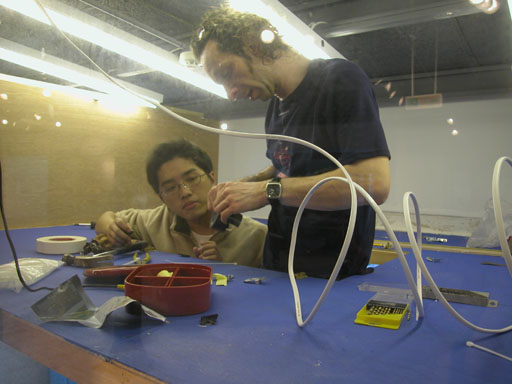
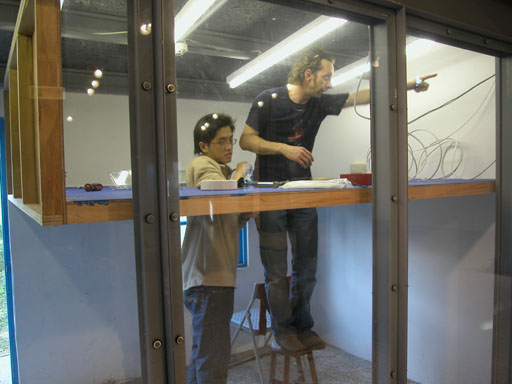
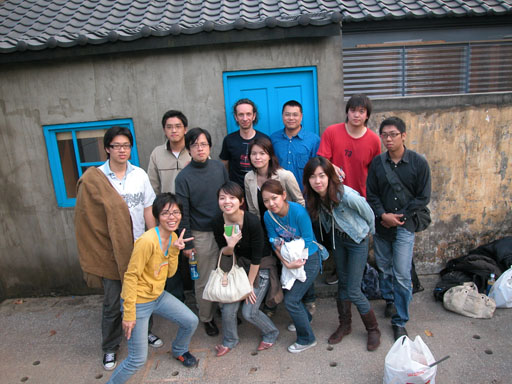
Artists in Residence at Taipei Artists Village from February 27th to May 6th 2006
Exhibition: HEADROOM, by Paul Sermon
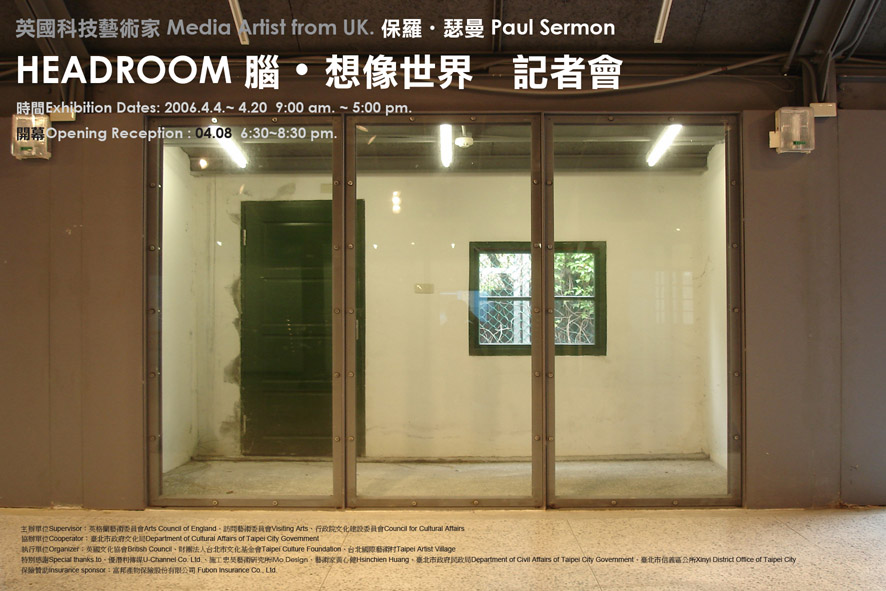
Exhibition Dates/Times: April 4th to 20th 2006, 9:00 am. to 5:00 pm. daily
Venue Address: Xinyi Public Assembly Hall ( No.50 Songqin St., Taipei)
Opening Event: April 8th 2006, 6:30 to 8:30 pm.
Gallery Talk: April 16th 2006, 3:30 to 4:30 pm.
'A small box of a room with a mattress, a few items of furniture and a small old black-and-white TV, it obviously represents a living space. A hole in the low ceiling, however, reveals something of a loft with a video monitor attached to a camera in that area and a similar one "next door."
Two people in the separate rooms are shown on the screen together, very realistically as if they were in each other's physical presence.'
"The fact that there is so much room in cyberspace, which is represented by the distance between the individuals on the monitor, Sermon says, is juxtaposed by the cramped environment of the small "bedroom."
"We are going to this new space of intimacy," Sermon added. "Between our physical presence and that in the Internet, we find ourselves asking "Do I exist here or this elaborative space.'"
The above abstracts are from Carmen Russell's article about 'Headroom' on 'The China Post' at [link]
Taipei, 7 April 2006
Dear Gabriella,
The press conference went well yesterday, and I also presented the diary web page to give some background information on the project which many of the media and press made a note of. I also had to give a short demonstration of the installation by pulling back the curtains in the upper headroom space to reveal how the entire installation functions. Which also made it easier for photographers to get a better visual impression of the piece. This seemed to help a lot, and my own use of the piece really helped people understand how the installation functions and what kind of interaction I intend.
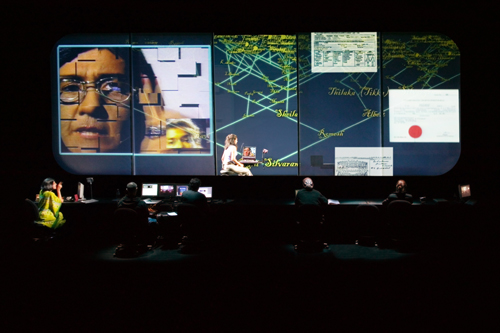
The piece is very intense, and puts the two participants' faces very close together. I think this is strangely intimidating and many people are particularly shy about this.
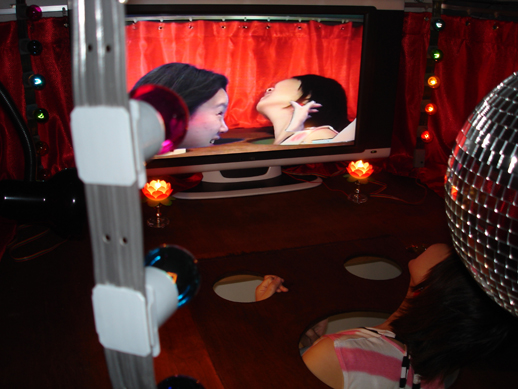
But I did explain this is exactly as I intended it - which helped.
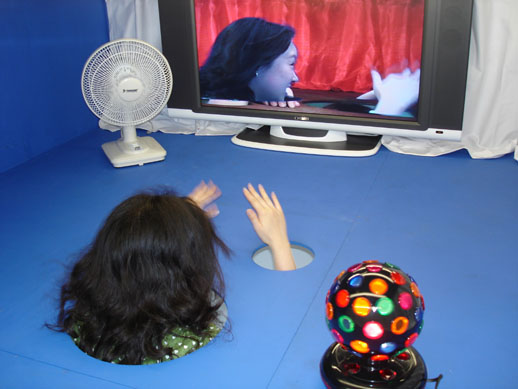
Two things have come out of this first reaction. I probably need to make some performance demonstrations of the piece to put the audiences' mind at rest about the function and intention of the piece, and I also need to reveal just a little of the interior of the headroom space above to the audience standing behind the glass wall to understand the entirety of the piece from one location.
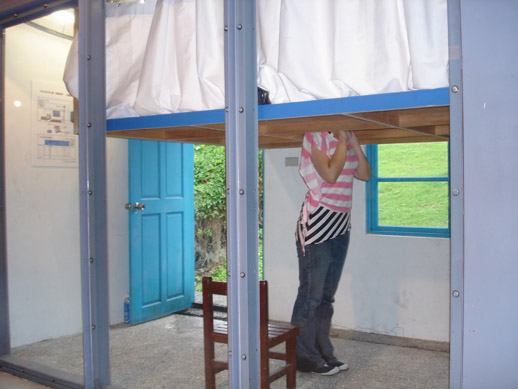
I need to make these and few other little changes before the private view event tomorrow evening and I will also record some video too to get a better evaluation of how it works. People have also talked a lot about how the head and body seem to be two different worlds and also observed in two different states.
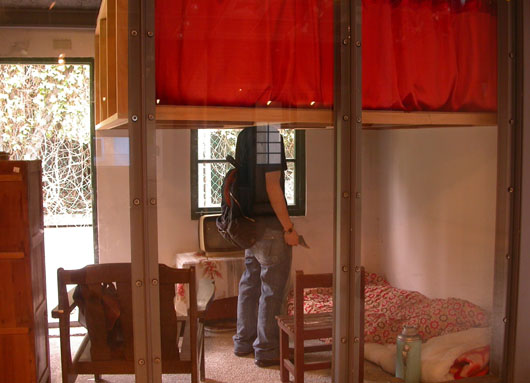
I'm very pleased with the lower space and the contrast between the above headroom space. This makes very clear sense and the narrative of the entire piece really unfolds in this total view.
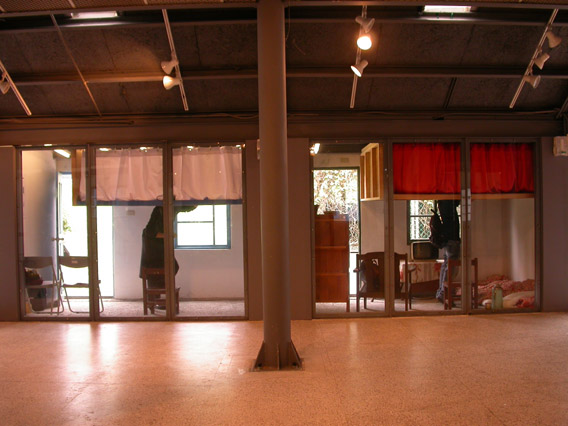
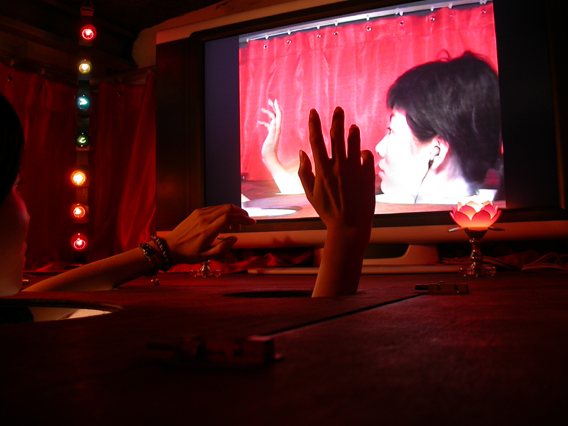
There are many people to thank and credit, and I will provide a list shortly.
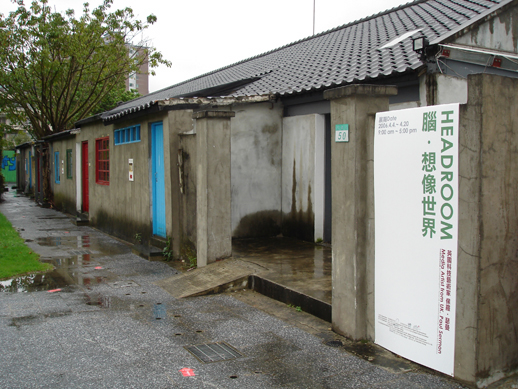
More soon, after the opening party event,
Paul
Taipei, 10 April 2006
Dear Gabriella
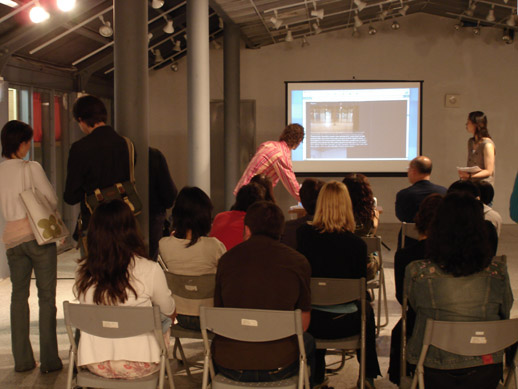
The opening of HEADROOM was a big success, drawing a large crowd of visitors with representatives from many of the supporting bodies including The Taiwan Council for Cultural Affairs, The Department of Cultural Affairs Taipei City Government, The British Council Taipei, Taipei Artist Village and the vice-mayor of Taipei City.
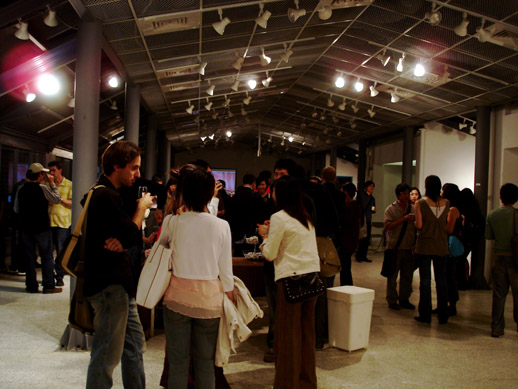
After the initial formalities and speeches many visitor participated in the installation without any hesitation, and I received a lot of positive feedback.
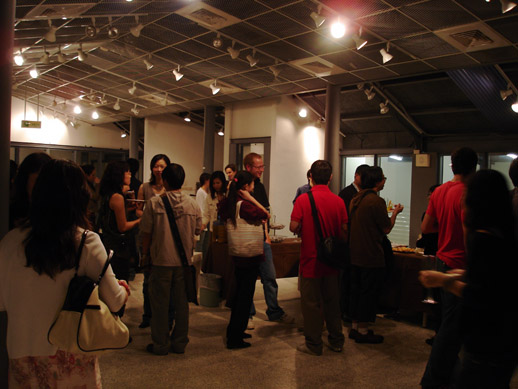
It always a relief to get such a good response at an opening like this, particularly for a new work.
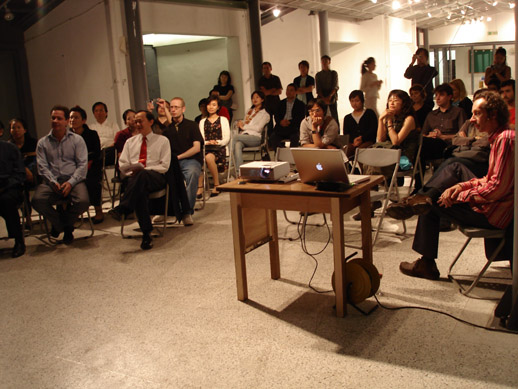
More audience evaluation to come.
Paul
Following up on the opening of HEADROOM I would like to add some very special thanks to:
Taipei Artists Village, Director Ms. Yaohua Su and her entire team including Cindy Wu, Ashley Y.H. Chang and Chin Mu, Mr. Huang and his crew of electricians and wood technicians.
Professor Yung-Hsien Chen and his students at the National Taiwan University of Arts
Taiwan Council for Cultural Affairs
Department of Cultural Affairs Taipei City Government
The British Council Taipei
Visiting Arts UK
Arts Council England
and my daughter Silke for her continual Skype conversations/tutorials
during my stay in Taipei.
Taipei, 12 April 2006
英國科技藝術家保羅‧瑟曼
HEADROOM 腦 . 想像世界 展覽室對話
弄偶者、表演者或虛擬人─ 在無線網路空間內的感觀差異
時間: 2006. 04.15 (六) 3:30~4:30 pm.
地點: 信義公民會館 (台北市信義區松勤街50號,近莊敬路與信義路口)
保羅‧瑟曼喜歡探索在遠端網絡的世界,並與遠端參與者在網域間互動。他透過色彩的調和以及視訊會議技術的運用,讓兩個空間內的參與觀眾,同時被連結在一個虛擬的空間中,變成一個可以互動的視覺裝置作品。
「腦‧想像世界」是保羅在台北的經驗,也是一個對照人們努力生活與企圖逃脫的作品。現場裝置將下層孤寂的房間,與上層因視訊科技所產生的熱情擁抱做了一個強烈的對比。此作品受 1990 Roy Ascott 的論文“Is There Love in the Telematic Embrace無線網域的擁抱裡有愛嗎?” 的影響。Ascott 陳述了評論家一般都認為科技毫無人性。但若是遠端科技藝術有擁抱愛的潛質,那麼電子設備和藝術將不再相互矛盾,同時又能符合人性的原則。回溯白南準早期的佛像影像裝置,「腦‧想像世界」則是一個藉由遠端視訊空間,以及觀者與表演者間親密的接觸,傳達自我反射的裝置作品。電視的「銀幕」在獨自觀看的參與者中,轉換成一個舞台及入口,進而產生了原因與結果。
展覽室對話中,保羅將分享他的「台北日記」駐村感想,以及「腦•想像世界Headroom」計畫的發想及過程實錄。歡迎親臨現場,與藝術家面對面,分享創作心得。
關於保羅‧瑟曼台北計畫: http://www.artistvillage.org/artist.php?id=6440
更多關於保羅‧瑟曼的消息: http://www.paulsermon.org
保羅‧瑟曼的台北日記: http://presence.stanford.edu:3455/Collaboratory/500
主辦單位:英格蘭藝術委員會、訪問藝術委員會、
協辦單位:臺北市政府文化局
執行單位: 財團法人台北市文化基金會、台北國際藝術村
特別感謝:臺北市政府民政局、臺北市信義區公所、施工忠昊工作室、優潛利傳媒 、藝術家黃心健
保險贊助:富邦產物保險股份有限公司
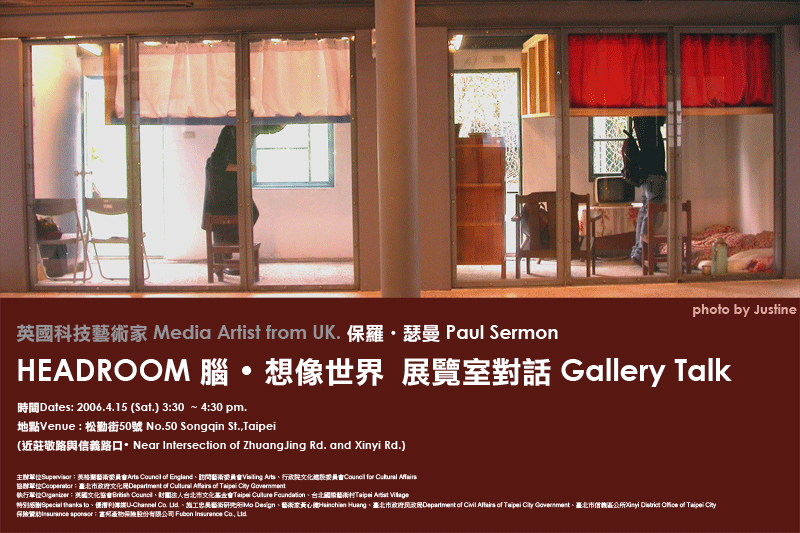
Residency Artist from UK. Paul Sermon’s HEADROOM Gallery Talk
Puppeteers, Performers or Avatas – A perceptual difference in telematic space
Date: 2006. 04.15(Sat.) 3:30~4:30 pm.
Venue Address: Xinyi Public Assembly Hall (No.50 Songqin St., Taipei)
Paul Sermon’s work in the field of telematic arts explores the emergence of a user-determined narrative by bringing remote participants together in a shared telepresent environment. Through the use of live chroma-keying and videoconferencing technology, two public rooms and their audiences are joined in a virtual duplicate that turns into a mutual, visual space of activity.
HEADROOM is a juxtaposition of Paul’s experiences in Taipei, between the way people live and the way people escape, as an analogy between the solitude presence in the bedroom space below and the divine telepresent aspirations in the Internet space above. This installation is also referencing Roy Ascott's essay, "Is There Love in the Telematic Embrace?" (1990), where Ascott addressed a common concern amongst critics that technology would dehumanise the arts. But if telematic art had the potential to embody love, it would not be paradoxical for art to be electronic and simultaneously serve humanist principles. Reminiscent of Nam June Paik's early Buddha TV installations, HEADROOM is a reflection of the self within the telepresent space, as both the viewer and the performer of this intimate encounter. The television 'screen' is transformed into a stage or a portal between the causes and effects that simultaneously take place in the minds of the solitary viewers.
Paul is going to share his diary about his residency experience in Taipei, and the process of the HEADROOM project.
About Paul Sermon’s projects in Taiwan, please check: http://www.artistvillage.org/artist.php?id=6440
More information about Paul Sermon, please check: http://www.paulsermon.org
Paul Sermon’s diary from Taipei: http://presence.stanford.edu:3455/Collaboratory/500
Supervisor:Arts Council of England, Visiting Arts
Cooperator:Department of Cultural Affairs of Taipei City Government
Organizer: Taipei Culture Foundation, Taipei Artist Village
Special thanks to 、U-Channel Co., Ltd. 、Hsinchien Huang、Department of Civil Affairs of Taipei City Government、Xinyi District Office of Taipei City
Insurance sponsored by Fubon Insurance Co., Ltd.
Exeter, 12 April 2006
Dear Paul
Many thanks for all the great images that arrived while we were away. Thank you also for the news clip. Is there any change of getting
permission to put it online?
I'm fascinated by the way Headroom has worked out. The red room looks, from a distance, like a very theatrical, illusionary space. The blue room, by contrast, appears to be more functional. Also the red room is the reconstructed bedroom, thus presenting itself, again, as a theatrical set, a space for drama (action) and spectacle (viewing). The blue room, on the other hand, is more like a gallery space, neutral and easy of the eye. Whereas in the red room, it seems, there is so much to see in the lower part of the room, in the blue room, the viewer appears to have nothing but the platform to go to. From the outsider point of view, which is very visible through the latest poster, there isn't however so much a front and back stage division as the juxtaposition of two entirely separate spaces, which, due to their sheer proximity, are meant to have something in common and yet, somehow, they never become synthesis. For me there really is a postmodern dialectic here, expressed visually in the impossibility of the two spaces to become one. And I love the idea that the external viewer, standing in front of the two spaces, actually sees 'nothing' but the real, whereas to see the telepreset space you actually have to be willing to be within it.
The pictures from the telepresent interactions are wonderful! People are so close to one another, it's extraordinary. This really beautifully visualises, for me, new media's ability to fragment space and render distance more complex. The viewers appear almost to dance around one another, rather sensually and, yes, I can imagine, playfully but also disturbingly due to the closeness and enclosed character of the space. There is something claustrophobic about this closenes, as well as the narrow headroom spaces, and the technology somehow augments this, by rendering this presence more fragmented, but also more intense, precisely because of and through this dispersal.
I wish I could be in Taipei and experience the work in person....
best
Gabriella
Taipei, 13 April 2006
Thanks for your email. I'm off to Taiching (mid Taiwan) today to give a talk, I will get back to you tomorrow.
Paul
Paul was in the Taiwan news. Watch the report at  Taiwan News TV.mov
Taiwan News TV.mov
Paul's work is also on Flickr at
[link]. All photos are by Meng-Lung Lee. Thanks also to Chun-I.
Taipei 14 April 2006
Dear Gabriella,
The TAV team have checked with the TV network about using the video on the website and its no problem as the clip includes the network logo etc.
I'm on a lecture circuit this week, this photo is from a lecture on Tuesday at Shih Chien University in Taipei with a group of undergraduate and postgraduate multimedia design students.
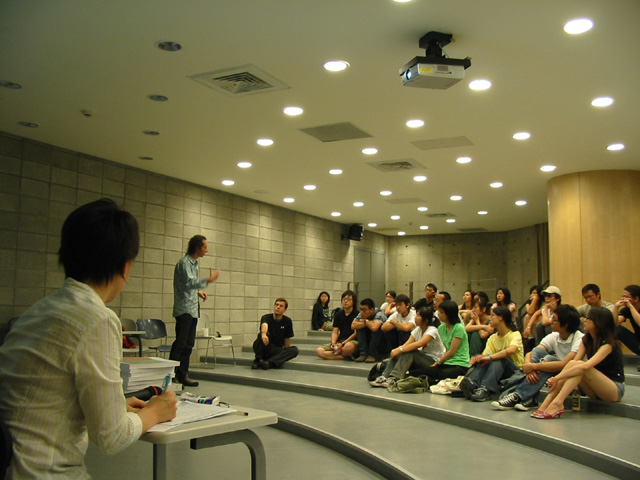
I also gave a lecture and research seminar yesterday at the National Taichung Institute of Technology with details on line at [link] and photos to come.
Best,
Paul
Taipei, 17 April 2006
Dear Gabriella,
This is exactly how it turned out. The two rooms have a very different appearance and function, and I decided to depict this by placing alternative description/information panels on the walls in each room. In the blue (control/technical) room I had a video flow diagram showing how the installation functions and in the red room I
used a conceptual statement that outlined the thinking behind the installation and the contrast between the makeshift bedroom below and the intimate headroom above.
In many ways the red room represents the primary installation space, whereas the blue room functions as the leading performers control room, always appearing in the dominant foreground position. In the image below the person on the left is in the foreground blue room and the person on the right is in the installation red room background.
These images are all taken from initial moments when the participants puts their heads into the space, sometimes friends, couples or strangers encounter on another. The reactions and subsequent interactions are often in complete contrast to the initial response when entering the solitary bedroom space below. It's important to consider and imagine the body standing in this space when looking at this selection of expressions and emotions in the video stills. I think these images really speak for themselves when we consider the dialectic between the two spaces you so accurately identified.
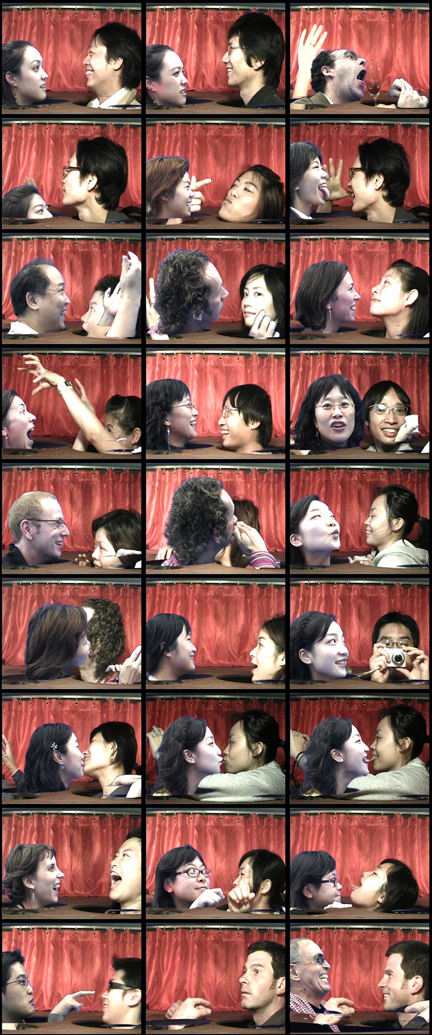
I was visiting the gallery yesterday and was asked by a visitor if I am currently sleeping in the bedroom space below during my stay in Taipei. I found this a really interesting observation and was very pleased someone genuinely thought this. I wanted the installation to appear as if somebody really was living here and had actually created this alternative headroom space to escape from the lonely world below. And that this bizarre installation was not created by an artist at all, but was actually something 'ready made' I simply came across.
The show ends on Thursday 20th April, and I will continue to documents it this week. After which I will travel to the south of Taiwan for a few days before returning to Manchester on May 6th.
More to come before I leave.
Best,
Paul
Exeter, 18 April 2006
Dear Paul
The images of the interactions are extraordinary - and as you say when you read them it's essential to remember the division of the body in the installation space as well as the overlaying of 'separate' spaces in the telepresent space.
I've found the intensity of these images and interactions very interesting - especially in relation to concepts of presence. The installation overtly intertwines - or even overlays - private and public space, and the sense of the 'inside' and 'outside' of the installation's 'place'. It seems to me that it's partly in this breaking down of oppositions that the participants' sense of the 'presence' of their co-performers is amplified.
In this aspect, Headroom radically extends a disruption of oppositions in which video art/installation and site-specific work has frequently operated.
Video art has often played on the 'intimacy' of television viewing, and so the placing and playing of a 'private' realm in a 'public' (gallery) space. Site-specific work, of course, frequently confuses the boundaries of the artwork and its site, so disrupting the boundaries between 'inside' and 'outside'.
In Headroom, co-performers discover themselves acting out a series of intertwinings of public/private, inside/outside. The installation itself and title emphasize the intimate nature of this overlaying of spaces - the aspect of fantasy or dream - while the public nature of the installation sanctions or appears to give permission or consent to this closeness. In this context, co-performers discover themselves 'coming closer' in a paradoxical distribution of presence - an intimacy produced by a telepresent distance.
Here, then, visitors discover themselves occupying and acting out their co-performer's private space, while seeing their own private space acted out by their telepresent partner. The spatial rules of public interaction are breached, producing an intimacy, a particular and shocking closeness, and a dialectic between the explicit sense of being here (in the bedroom, for example) and being there (acting out the space of the other), while seeing and responding to their co-performer's mirrored response.
In these ways, Headroom suggests all kinds of associations and processes in which presence might be articulated and amplified: in processes of mirroring and multiplication; in a breaking down or reversal of spatial boundaries; in a breaking of the 'rules' of decorum; in plays between performance, the real and representation.
We will continue thinking this through and look forward to developing material here further.
Hope you enjoy your travels from the 20th.
Very best,
Nick
Link to Paul Sermon's workshop on the project in Taiching [link]
Taipei, 23 April 2006
Dear Nick, Gabriella,
I'm almost ready to leave for my trip to the south now. All that remains to do when I return is show the video clips from HEADROOM at the leaving party hosted by the British Council Taipei on May 4th at the VT Art Salon (http://www.vtartsalon.com/). It's been an interesting last few days of the show. Having discussed the installation more and more with gallery visitor and students, the paradox you talk of has become more evident in the interpretation of the work. At every level, from the geography of the space, the architecture of the building, the solitude of the bedroom, and the shared intimacy in the headroom it all points towards the network reference I originally drew my thoughts and inspiration from. There is an acute sense of departure of the head from one space to the other, yet leaving the body behind - as in the telematic travel from the bedroom to the MSM or yahoo video chat room.
Some final shots from HEADROOM....
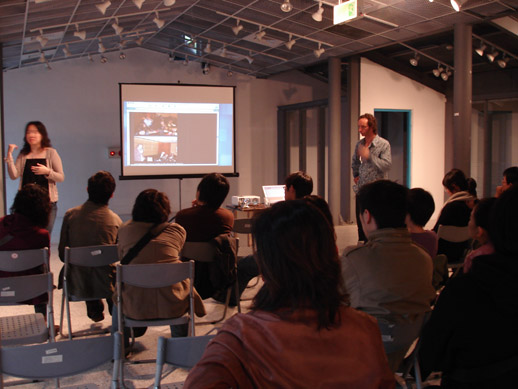
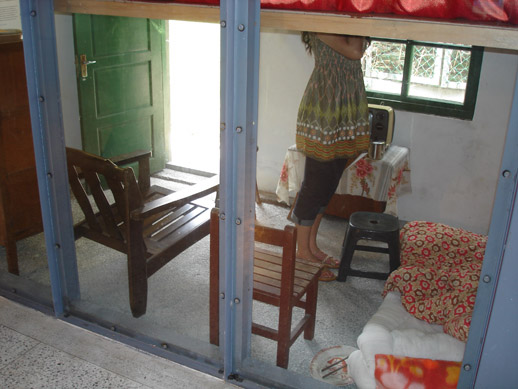
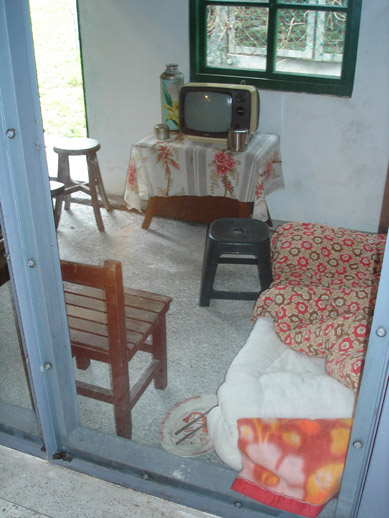
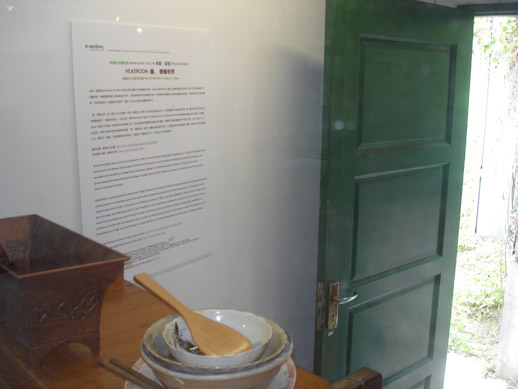
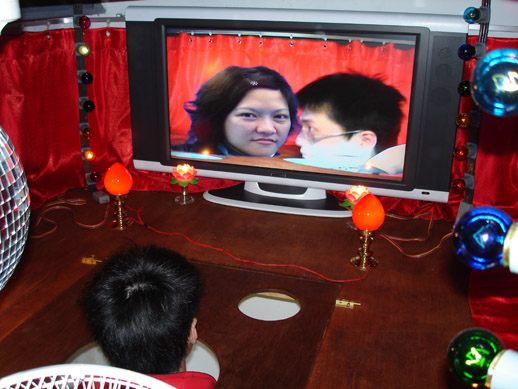
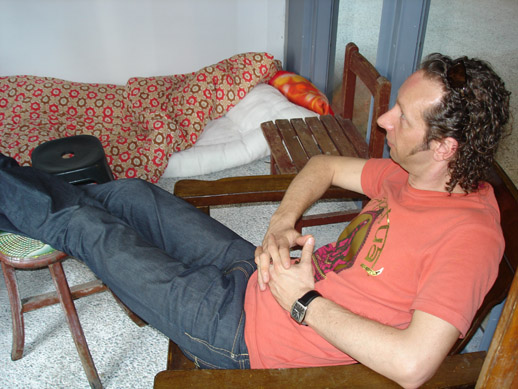
and taking the show down on the 21 April....
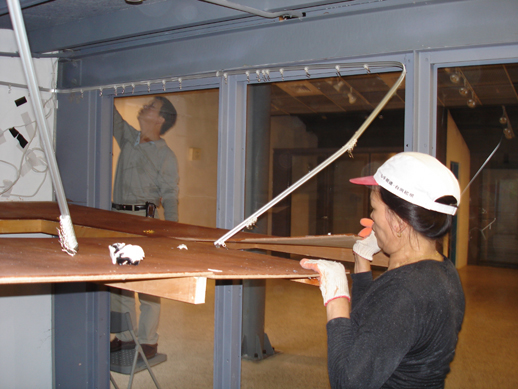
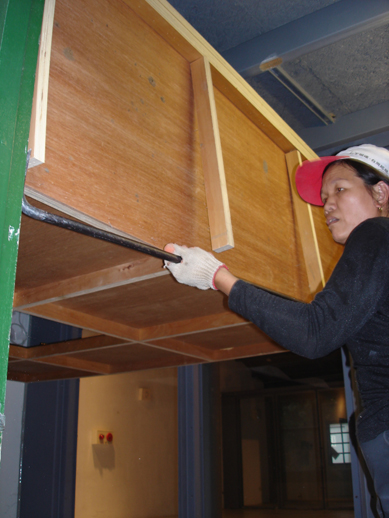
I will send my final update on the HEADROOM web site and documentary video made by the students of the National Taiwan University of the Arts after the leaving party on April 5th.
Many thanks for all your continued thought provoking messages and questions, it's all been a huge inspiration and motivation for me.
Best,
Paul
All images are courtesy of Paul Sermon.
The Documentation of Headroom is now concluded. The Presence Project wishes to thank
Paul Sermon for dedicating so much time, enthusiasm and energy to the documentation of his fascinating and groundbreaking project. See also
Acknowledgements




















































 Taiwan News TV.mov
Taiwan News TV.mov








